Trip to Warsaw
Table of Contents
- Match: Poland - Faroe Islands
- Centrum Nauki Kopernik (en. Copernicus Science Centre)
- Muzeum Powstania Warszawskiego (en. Warsaw Uprising Museum)
- National Stadium Tour
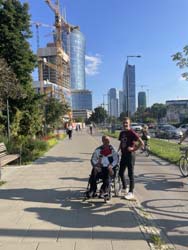
Travel Plans to Warsaw
I planned my trip to Warsaw right after returning from the Kraków and Wieliczka tour in 2019, but the pandemic disrupted my plans. In 2023, as soon as the opportunity arose, I started organizing the trip. The main goal was to explore the capital's attractions, with a priority on finding a hotel suited for people with disabilities, near a metro station to make city transportation easier.
Accessible Hotel in Warsaw
In Warsaw, finding wheelchair-accessible hotels is not difficult. We chose one located on al. Solidarności. Its location near the metro made it easy and convenient to reach attractions like the Copernicus Science Centre, the Warsaw Uprising Museum, and the National Stadium. I also planned a walk along Krakowskie Przedmieście, Castle Square, and the Old Town Market. A few days before the trip, we managed to buy tickets for the Poland - Faroe Islands match, part of the European Championship Qualifiers.
How to Buy a Ticket for a Match at the National Stadium?
Purchasing a ticket for the Poland - Faroe Islands football match was straightforward through the site łączynaspiłka.pl. I just had to register, submit a disability certificate photo, which was verified within a few hours, and choose a wheelchair-accessible seat. The ticket came in a package with a companion, making it the most affordable option, even though it admitted two people.
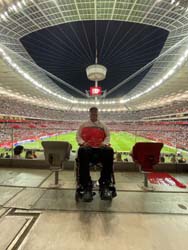
How to Reach the National Stadium for a Match with a Wheelchair?
We reached the National Stadium by metro about an hour before the match. It's over a kilometer from the metro station to entrance number 1, designated for disabled visitors. After our tickets were checked, we were provided with an assistant who guided us through Królaka Tunnel, a remnant of the old Tenth Anniversary Stadium, to the next assistants. From there, we were directed to elevators that took wheelchair-using fans to the accessible seating level.
Experience at the National Stadium Match
The first impression when we exited the elevator was overwhelming. The huge crowd, loud cheers, and sheer height of the stadium were astounding. It took a few minutes for the awe and excitement to settle. We easily found our seats, and despite being behind the goal, we had a clear view of everything happening on the pitch. With no lines, we bought beers and calmly awaited the first whistle.
One of the most beautiful moments was singing the National Anthem with 54,000 people before the match began. Seeing the entire stadium in white and red colors is a priceless sight that will stay in my memory forever. Sadly, the level of play, especially in the first half, was disappointing, and the team was booed. Fortunately, we won this lackluster game 2-0.
After the final whistle, we left the stadium smoothly. I feared a long wait for the elevators due to the number of wheelchair users, but it took only 10 minutes to get down to the ground level. The metro ride back to the hotel was also pleasantly uncrowded. We were tired but happy to have watched Poland's national team play at the National Stadium.
Copernicus Science Centre in Warsaw
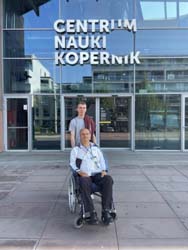
The Copernicus Science Centre is an amazing place that focuses on promoting science, working with scientists and educators, and inspiring people to observe, experiment, ask questions, and seek answers.
Since learning about this fascinating, fully accessible place for wheelchair users, I decided to visit it at the first opportunity.
How to Buy a Ticket to the Copernicus Science Centre?
Tickets for a specific time slot can be purchased online, but we were able to enter several minutes early without any issues. The tour begins with an impressive Foucault's pendulum, proving Earth's rotation. There are countless attractions and exhibits, including a prototype of a futuristic autonomous Mercedes and a massive cross-section of a sequoia tree.
Exploring the Copernicus Science Centre in a Wheelchair
The entire exhibition area spans two floors, divided into thematic sections, such as sound, light, etc. Moving around the Copernicus Science Centre in a wheelchair is very easy, allowing access to many attractions or the chance to watch others interact with them. It's an enriching experience for anyone interested in science and the mechanisms governing the world. You can spend just a few hours or an entire day, depending on your curiosity.
The attraction also has a rooftop garden accessible by a ramp outside the building. The plants were a bit of a disappointment, but it's worth the climb for the panoramic view of Warsaw and the Vistula River. The planetarium at the Copernicus Science Centre is another attraction, though it was closed that day.
Is it Worth Visiting the Copernicus Science Centre in Warsaw?
Compared to a visit to Hydropolis in Wrocław, the Copernicus Science Centre offers a much richer and more diverse range of interactive exhibits. Here, on a larger scale, the creators demonstrate that physics and chemistry can be fascinating and useful.
The Copernicus Science Centre isn't a traditional museum where nothing can be touched. Its biggest value lies in encouraging hands-on interaction. Short descriptions help you understand what to press and in what sequence to initiate and comprehend each experience.
Warsaw Uprising Museum

Everyone I know who's visited the Warsaw Uprising Museum highly recommended it, so I decided it was worth a visit, especially since it is accessible for wheelchair users. I purchased tickets online with all-day entry access.
Most rooms in the museum are styled like the streets of 1940s Warsaw, enhancing the atmosphere of that era. The rooms contain numerous traditional artifacts as well as modern multimedia exhibits. Highlights include a Liberator plane that provided supplies during the fight against Germany, weapon exhibits, and a self-propelled mine. A key feature of the museum is a short 3D film titled "City of Ruins."
Is the Warsaw Uprising Museum Worth Visiting for a Person with Disabilities?
Moving around the museum in a wheelchair is fairly easy, although cobblestones dominate the space. Elevators made it easy to reach different floors. The route follows a timeline, leading through thematic rooms. The museum also has an observation tower with views over Warsaw.
Is the Warsaw Uprising Museum worth visiting? Absolutely. The reasons vary, but most importantly, it pays tribute to the heroes who took on the occupiers. Touring the museum provides a deeper understanding of modern Warsaw and the motivations behind the Uprising.
National Stadium Tour
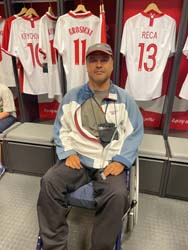
Two days after the Poland - Faroe Islands match, we had purchased tickets online for a tour of the National Stadium. Unfortunately, entrance number 1, indicated on our ticket, was closed due to preparations for a new event, so we had to search for entrance six, which required us to turn around, making it not so easy.
We reached the elevators through the underground parking and soon arrived at the reception, where the tour begins.
National Stadium Tour Route in Warsaw
Our group consisted of about 30 people, and I was the only person in a wheelchair. We started the tour with an assistant, who guided me and my companion to the level with seats for disabled fans. Due to preparations for the next event, the field had already been removed, and the empty stands didn't have the same impact as they did on match day. The rest of the group joined us, and we continued exploring the stadium's various levels together using the elevators. We visited the business area, the national team's locker room, the conference room, the viewing point, and the pitch level. We also saw a replica of the Polish Cup and a room filled with memorabilia.
Overall, in terms of attractions, the National Stadium tour is moderately interesting. Perhaps my impression is influenced by the incredible atmosphere I experienced on match day. I can only add that I found the Śląsk Wrocław Stadium tour to be much more engaging.
Warsaw - a modern city friendly to people with disabilities
I'm very glad to have finally seen Warsaw after so many years. My last visit was 34 years ago, when I could still walk, and it was a different city. The Pałac Kultury i Nauki (Palace of Culture and Science) used to be the main landmark, visible from almost everywhere. Now, it's often obscured (thankfully) by modern skyscrapers. Years ago, Warsaw was a gray and gloomy city; today, it's a vibrant European capital we can be proud of.
In terms of accessibility, Warsaw is well-prepared. Elevators, ramps, and lowered curbs are found everywhere. Even around Plac Zamkowy (Castle Square) and the Old Town, navigating by wheelchair was manageable. The metro system could serve as a model for accessible public transportation. I hope all cities follow Warsaw's example.
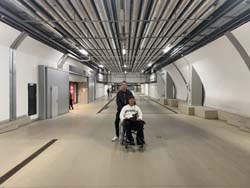
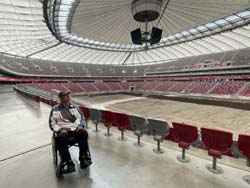
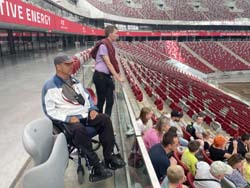
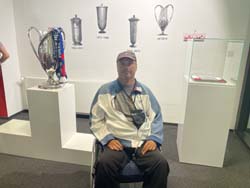
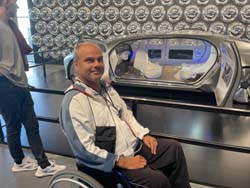
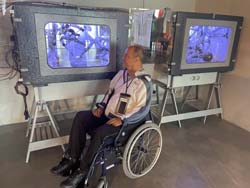
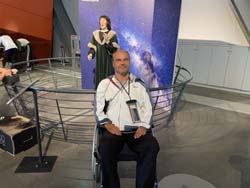
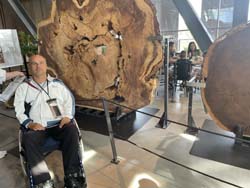
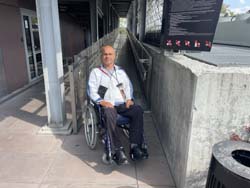
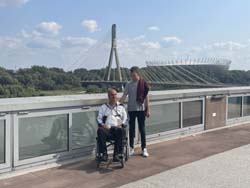
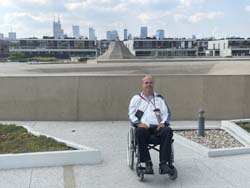
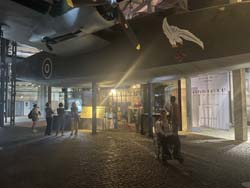
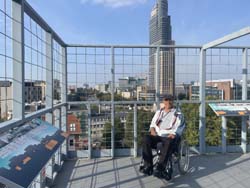
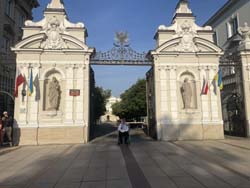
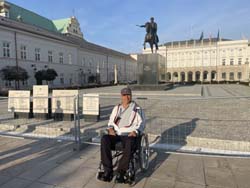

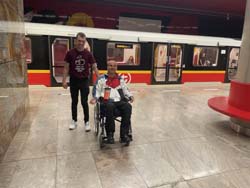
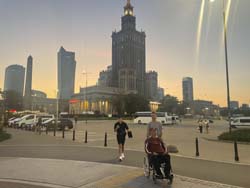
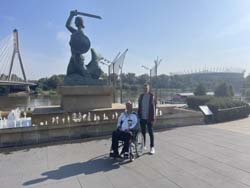
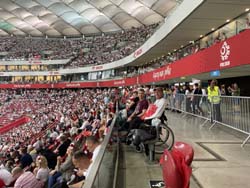
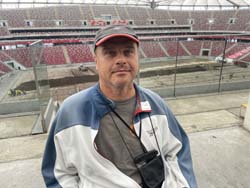

 PL
PL
 DE
DE